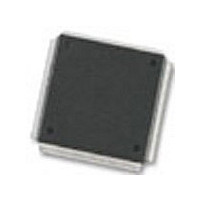MC68376BAMFT20 Freescale Semiconductor, MC68376BAMFT20 Datasheet - Page 153

MC68376BAMFT20
Manufacturer Part Number
MC68376BAMFT20
Description
Manufacturer
Freescale Semiconductor
Datasheet
1.MC68376BAMFT20.pdf
(434 pages)
Specifications of MC68376BAMFT20
Cpu Family
68K/M683xx
Device Core
ColdFire
Device Core Size
32b
Frequency (max)
20MHz
Interface Type
QSPI/SCI
Program Memory Type
ROM
Program Memory Size
8KB
Total Internal Ram Size
7.5KB
# I/os (max)
18
Number Of Timers - General Purpose
2
Operating Supply Voltage (typ)
5V
Operating Supply Voltage (max)
5.25V
Operating Supply Voltage (min)
4.75V
On-chip Adc
16-chx10-bit
Instruction Set Architecture
RISC
Operating Temp Range
-40C to 125C
Operating Temperature Classification
Automotive
Mounting
Surface Mount
Pin Count
160
Package Type
PQFP
Lead Free Status / Rohs Status
Not Compliant
Available stocks
Company
Part Number
Manufacturer
Quantity
Price
Company:
Part Number:
MC68376BAMFT20
Manufacturer:
FREESCAL
Quantity:
245
- Current page: 153 of 434
- Download datasheet (7Mb)
9.2.1.2 Freeze Operation
9.2.1.3 QSM Interrupts
MC68336/376
USER’S MANUAL
The FRZ[1:0] bits in QSMCR are used to determine what action is taken by the QSM
when the IMB FREEZE signal is asserted. FREEZE is asserted when the CPU32 en-
ters background debug mode. At the present time, FRZ0 has no effect; setting FRZ1
causes the QSPI to halt on the first transfer boundary following FREEZE assertion.
Refer to 4.10.2 Background Debug Mode for more information about background de-
bugging mode.
Both the QSPI and SCI can generate interrupt requests. Each has a separate interrupt
request priority register. A single vector register is used to generate exception vector
numbers.
The values of the ILQSPI and ILSCI fields in QILR determine the priority of QSPI and
SCI interrupt requests. The values in these fields correspond to internal interrupt re-
quest signals IRQ[7:1]. A value of %111 causes IRQ7 to be asserted when a QSM in-
terrupt request is made. Lower field values cause correspondingly lower-numbered
interrupt request signals to be asserted. Setting the ILQSPI or ILSCI field values to
%000 disables interrupts for the respective section. If ILQSPI and ILSCI have the
same non-zero value, and the QSPI and SCI make simultaneous interrupt requests,
the QSPI has priority.
When the CPU32 acknowledges an interrupt request, it places the value in the status
register interrupt priority (IP) mask on the address bus. The QSM compares the IP
mask value to the priority of the request to determine whether it should contend for ar-
bitration priority. Arbitration priority is determined by the value of the IARB field in
QSMCR. Each module that generates interrupts must have a non-zero IARB value.
Arbitration is performed by means of serial contention between values stored in indi-
vidual module IARB fields.
When the QSM wins interrupt arbitration, it responds to the CPU32 interrupt acknowl-
edge cycle by placing an interrupt vector number on the data bus. The vector number
is used to calculate displacement into the CPU32 exception vector table. SCI and
QSPI vector numbers are generated from the value in the QIVR INTV field. The values
of bits INTV[7:1] are the same for QSPI and SCI. The value of INTV0 is supplied by
the QSM when an interrupt request is made. INTV0 = 0 for SCI interrupt requests;
INTV0 = 1 for QSPI interrupt requests.
At reset, INTV[7:0] is initialized to $0F, the uninitialized interrupt vector number. To
enable interrupt-driven serial communication, a user-defined vector number must be
written to QIVR, and interrupt handler routines must be located at the addresses point-
ed to by the corresponding vector. Writes to INTV0 have no effect. Reads of INTV0
return a value of one.
Refer to SECTION 4 CENTRAL PROCESSOR UNIT and SECTION 5 SYSTEM IN-
TEGRATION MODULE for more information about exceptions and interrupts.
QUEUED SERIAL MODULE
MOTOROLA
9-3
Related parts for MC68376BAMFT20
Image
Part Number
Description
Manufacturer
Datasheet
Request
R
Part Number:
Description:
Manufacturer:
Freescale Semiconductor, Inc
Datasheet:
Part Number:
Description:
Manufacturer:
Freescale Semiconductor, Inc
Datasheet:
Part Number:
Description:
Manufacturer:
Freescale Semiconductor, Inc
Datasheet:
Part Number:
Description:
Manufacturer:
Freescale Semiconductor, Inc
Datasheet:
Part Number:
Description:
Manufacturer:
Freescale Semiconductor, Inc
Datasheet:
Part Number:
Description:
Manufacturer:
Freescale Semiconductor, Inc
Datasheet:
Part Number:
Description:
Manufacturer:
Freescale Semiconductor, Inc
Datasheet:
Part Number:
Description:
Manufacturer:
Freescale Semiconductor, Inc
Datasheet:
Part Number:
Description:
Manufacturer:
Freescale Semiconductor, Inc
Datasheet:
Part Number:
Description:
Manufacturer:
Freescale Semiconductor, Inc
Datasheet:
Part Number:
Description:
Manufacturer:
Freescale Semiconductor, Inc
Datasheet:
Part Number:
Description:
Manufacturer:
Freescale Semiconductor, Inc
Datasheet:
Part Number:
Description:
Manufacturer:
Freescale Semiconductor, Inc
Datasheet:
Part Number:
Description:
Manufacturer:
Freescale Semiconductor, Inc
Datasheet:
Part Number:
Description:
Manufacturer:
Freescale Semiconductor, Inc
Datasheet:











